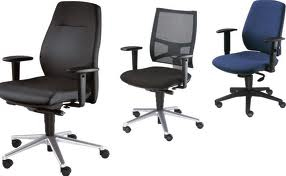Ergonomics
Ergonomics is the science of designing the workplace, machines, and work tasks within the capacity and capability of the human body.

It is a proactive approach that strives to fit the work to the worker, not the worker to the work. By understanding basic ergonomics and its interaction with your job, you can work more efficiently and comfortably, help prevent injuries, and promote your long-term health.
Try before you buy! Because each department is responsible for ergonomic upgrades, it's nice to try a chair before you buy. Contact Human Resources and schedule a visit to see the ergonomic chairs we have in stock (adjustable lumbar support, sliding seat panels, adjustable arms, mesh or fabric) in varying prices.
Items purchased to address general ergonomic issues (e.g., mice, keyboard trays, monitor arms, task lighting, chairs, etc.) are considered office supplies and must be ordered through the College's approved vendors. These purchases are paid through the individual's department with supervisory/department head approval. Human Resources can assist you with the recommended ergonomically correct tools and office equipment.
Additional Resources
- Stretch Breaks! Working at a desk all day can take a toll on your neck, shoulders and other muscles. Breaking up your workday with stretches and other physical activities can help you keep comfortable. Print out this small brochure and post it near your desk as a reminder to stretch throughout the day!
- 10 Tips for a Perfect Fit Worksheet: Thinking about rearranging your workstation? Review this one page guide of quick tips from MEMIC. For an in-depth review, follow the more extensive guidelines in Ergonomics in the Office: A Guide to Proper Workstation Design.
- Ergonomic Tips: Occupational Safety and Health Administration (OSHA) eTool* illustrates simple, inexpensive principles that will help you create a safe and comfortable computer workstation.
- Back Safety: Nearly 70% of low back pain is caused by what is known as "manual material handling," i.e., the lifting, pushing, pulling, carrying or even lowering work, follow these general lifting guidelines.
- Tips for Using a Laptop Computer: Many of us use laptops in docking stations in our offices or can conveniently take them with us when we travel. But laptop design (small keyboard with smaller attached screen) is an ergonomic challenge. Review these tips to make using more laptop more comfortable and ergonomically correct.
- Back Injury Prevention: Preventive measures you can take to reduce the chances of sustaining a back injury.
- What Makes a Good Chair
- Safety Works! Annual Maine Video Display (VDT) Training
If you have questions or you would like to schedule an appointment for an ergonomic evaluation, please call Human Resources at 207-725-3688.